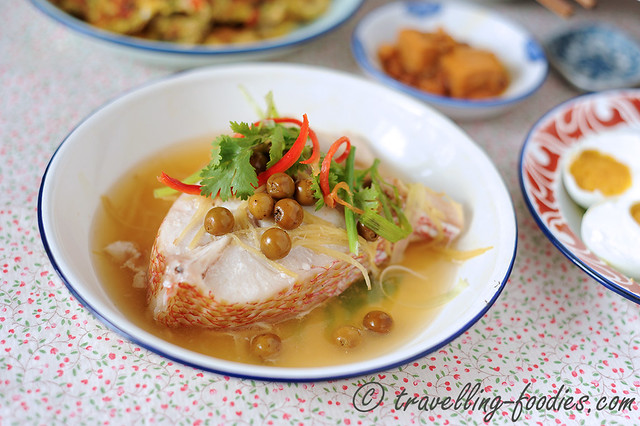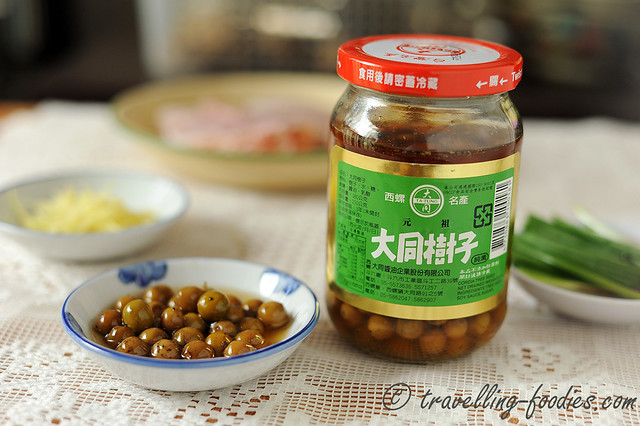破布子蒸鱼 Steamed Fish with Pickled Manjack Berries

Whenever we visit Taiwan, we love to bring back some of their local delights home. The usual culprits would be their 凤梨酥 pineapple cakes, 咔哩咔哩 twirly rice crackers and more recently organic fruit conserves using local fruits. But we also like to buy back some ingredients and condiments to prepare some dishes which allows us to savour those unique yet familiar flavours. Their 龙眼蜜 longan honey is more superior than those produced in Thailand while their 黑酱油 dark soya sauce is more aromatic than the varieties we get back home. Oh oh oh! And we love their seasonal fruits of course like 玉荷包 lychees and 艾文 mangoes! Quite recently, I was recommended by a friend,SF to try the Taiwanese pickled manjack berries known locally as 树子 shu zi, or more colloquially in Taiwanese dialect as 破布子 po bu zi. I love the Taiwanese 豆腐乳 fermented beancurd cubes so I thought their pickled manjack berries couldn’t taste that bad. And indeed, it was love at first bite!

Truth be told, prior to SF telling me about these small berry-like fruits, I had no idea about their existence. A quick google landed me some answers to these curious looking things. Manjack berries are harvested from a tropical species Cordia dichotoma whose distribution spans from subcontinental India all the way to the southern coastal regions of China. It can also be found in Malaysia purportedly and one tree had been “uncovered” in Singapore a couple of years ago, planted in the backyard of a small Buddhist temple some 30 years back. This got me very curious, on how such a common fruiting tree would have gone unnoticed all these years. In Taiwan, they are planted as wayside trees which flanked both sides of streets, especially in central and southern Taiwan. Come fruiting season, all the womenfolk in the villages and small towns would come together to harvest the fruits and pickle them for months to enjoy ahead. During our most recent trip to Taiwan, I see to it that I must get myself a bottle of pickled 破布子 amongst the honeys, soya sauce and whatnots of course.

In Teochew cuisine, pickled plums are commonly used in steaming fish which leads much of its flavour to the meat, so strong that it is often used as the sole condiment. Well, pickled 破布子 taste somewhat similar, also a melange of savory and tangy hues with slight fruity overtones, but much more subtle than what pickled plums are like. It also has an interesting flavour which reminds one of olives! The way to incorporate 破布子 into your steamed fish is just like how one would just sour plums. Make sure your fish is uber fresh and with some julienned ginger and a good drizzling of the pickling liquids, the fish is ready for a sauna! If you like a bit of “kiam kiam” and a bit of “sng sng” in your steam fish then do try to get a bottle of these the next time you visit Taiwan.

Steamed fish with pickled manjack berries goes very well with porridge and other side dishes. I like the flavours which it imparts unto the fish, moreish without being too heavy handed.

破布子蒸鱼 – Steamed Fish with Pickled Manjack Berries (Serves 2-3)
Ingredients
One thick slab of meaty fish which is good for steaming. Red or White Snapper, Threadfin or Garoupa are excellent choices.
1 generous soup spoonful of picked 破布子 po bu zi manjack berries
1 spoonful of 破布子 pickling liquids
A knob of old ginger, julienned
Sliced red chilies, coriander leaves, spring onions for garnishing
Method
Place the steak of fish onto a steaming dish and place some julienned old ginger both on top and beneath the fish.
Ladle a spoonful of 破布子 over the fish and drizzle some of the pickling liquids over it.
When the water in the steamer has come to a rolling boil, place the steaming dish into the steamer and steam at high heat for 12-15 min, depending on the thickness of the fish.
After the fish is cooked, remove from steamer and garnish with red chilies, coriander leaves and spring onions.
Serve immediately with an assortment of dishes that go well with chinese porridge. My favorites are chai por neng (pickled white radish omelette), kiam neng (salted eggs) and dau joo (fermented beancurd cubes), all of which you can see in one of the photos above!

And after a good porridge meal of 清粥小菜, time for something sweet! Thank goodness I “simpan” a serving of the “sago gula melaka” I made yesterday. 饭后甜点是一定要的啦!

非常古早味道的一餐。好想念地 。。。。。。
April 24, 2015 at 10:37 am
Pingback: Porridge Postulations – Part 1 清粥小菜 – 第一篇 | travellingfoodies